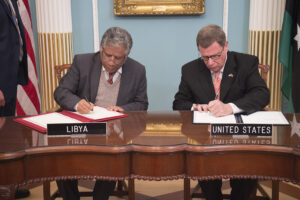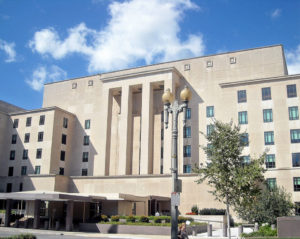
On February 23, 2021, Under Secretary of State for Public Diplomacy and Public Affairs I. Steven Goldstein and Libyan Ministry of Foreign Affairs Under Secretary for Political Affairs Lutfi Almughrabi signed the first bilateral MOU on cultural property protection at the U.S. Department of State’s Treaty Room.
Academia is tough these days, particularly for those devoted to fields outside “practical” science, technology, engineering, mathematics or other STEM disciplines. Humanities programs are being cut back or even eliminated. Archaeology, despite its scientific aspects, is viewed more as a humanities program and has suffered accordingly. Even before all the emphasis on STEM, there simply weren’t that many traditional museum and university jobs or field work available. As a result, necessity has forced graduates in archaeology to gravitate to other fields. Some apply their knowledge working as cataloguers for the antiquities and coin trades. Others leave archaeology altogether to make ends meet. Thanks to government largess, however, lucrative new opportunities have arisen for a select few archaeologists working with State Department bureaucrats to help justify cultural property Memorandums of Understanding (MOUs) or “emergency import restrictions.” Not surprisingly, such work often draws those most committed to the view that cultural artifacts should be clawed back from U.S. collectors and museums for the benefit of countries that have been victimized in the past by Western colonialism. Most collectors, dealers and museum curators have no idea about all the State Department money that is funding this jihad against the private ownership of cultural goods in the U.S.

Roman sculptures in Red Castle Museum, Tripoli, 2012, Author Libiya11, 8 June 2012, CCA-SA 3.0 Unported license, Wikimedia Commons. The museum is now reportedly open, however not even U.S. officials can travel to Libya today.
The U.S. State Department Bureau of Educational and Cultural Affairs (ECA) and its Cultural Heritage Center have done more than anyone to grow this new cottage industry through grants and contracts as part of their “soft power” efforts that seek to make hostile third world governments “like us more.” Congress intended to limit State Department discretion to enter into such MOUs and impose related import restrictions through the detailed findings that are required under the Cultural Property Implementation Act (CPIA), 19 U.S.C. § 2601 et seq. However, State Department bureaucrats have often been able to “check the box” for meeting minimum requirements by citing the work of State Department contractors as the necessary “evidence” required to complete such agreements under the governing law.
To date, the long-established American Society of Overseas Research (ASOR) has been a major grant recipient and “evidence maker” for some of the most difficult to justify MOUs.[2] In particular, the State Department has heavily funded ASOR’s Cultural Heritage Initiatives which focus on fighting looting in conflict zones like Syria and Libya.[3] According to a report prepared by ASOR’s Executive Director for a 2022 board meeting, ASOR relies heavily on the $500,000-$700,000 it receives annually in State Department grants and contracts for its overall staffing purposes.[4]
Critics have wondered whether all this money has encouraged ASOR to concoct false or misleading narratives about the nature and extent of looting to help justify such major funding. In one instance, an archaeologist associated with ASOR, working under a $600,000 State Department contract, was identified as the source for a widely reported false claim that the ISIS terror group’s profits from antiquities looting were “second only to the revenue the group derives from illicit oil sales.[5]”

Dar El Bishi Synagogue, Tripoli, Libya, today.
In another case, ASOR’s Executive Director, working under a $800,000 contract, was criticized for rendering an overly rosy picture of Libya’s efforts to protect its own cultural patrimony to help justify a cultural property MOU with “the internationally recognized government of Libya,” which in fact represents only one faction in an ongoing civil war.[6]
A giveaway should have been the fact that Libya is so dangerous that the U.S. no longer operates an embassy within the country. Instead, U.S. officials engage Libyans and monitor U.S. aid programs from the Libya External Office which is physically located at the U.S. Embassy in Tunisia. Indeed, the ASOR report used to justify renewing the MOU with Libya was evidently prepared solely based on interviews with Libyan officials that were conducted in Tunis, Tunisia, not in Libya itself.[7] Of course, no one associated with ASOR or the State Department questioned whether it was appropriate to repatriate objects there if it was too dangerous to travel there.

Former Tripoli, Libya Christian Cathedral converted to Mosque. Courtesy JIMENA.
More fundamental issues also arise about ASOR’s work. First, ASOR offers unqualified support for local laws of countries that declare all antiquities state property.[8] Given where ASOR operates, this effectively means that ASOR advocates for the U.S. to enforce confiscatory laws imposed by Middle Eastern dictatorships. During a 2022 State Department Cultural Property Advisory Committee (CPAC) hearing on Libya, the results of such thinking became readily apparent to those watching the proceeding. Rather than condemning Libya’s confiscation and destruction of the cultural heritage of its displaced Jewish minority, ASOR’s Executive Director ducked a straightforward question from a CPAC member as to whether Jewish artifacts should be excluded from any MOU.[9] There also is a potential issue related to lobbying. ASOR has certainly advocated for import restrictions on behalf of countries where it operates, but doing so again raises conflict of interest questions given the related federal funding it receives. In short, is ASOR’s work geared to conservation efforts or promoting government control over imports of cultural goods?
ASOR may be the largest but is certainly not the only beneficiary of State Department largess. Other programs offer additional funding opportunities. For some time, ECA has also administered the “Ambassador’s Fund for Cultural Preservation.” The Ambassador’s Fund “supports projects to preserve a wide range of cultural heritage in less developed countries, including historic buildings, archaeological sites, ethnographic objects, paintings, manuscripts, and indigenous languages and other forms of traditional cultural expression.”[10]

Vladimir Putin embraces Syria’s Bashir al Assad, 2017.
The State Department acting as both decision maker and facilitator for cultural property MOUs raises other concerns. More recently, the State Department has dropped all pretense of following the intent of the CPIA by showering additional funding on archaeologists to facilitate new and renewed cultural property MOUs. As part of the limitations on executive authority built into the CPIA, Congress required that source countries “did their own homework” before asking the U.S. to agree to a cultural property MOU that would assist them to enforce their export controls. According to the CPIA, MOUs should only be processed after receiving detailed requests from source countries and only completed after these countries had undertaken their own “self-help” efforts to protect their own cultural heritage.[11] However, lack of capacity or even motivation have proved to be obstacles, so in order to complete as many MOUs as possible, the State Department has “sweetened the deal” with more taxpayer money. Requests for MOUs have been funded with the help of the Antiquities Coalition (AC), another well-funded archaeological advocacy group that itself frequently lobbies both here and abroad for import restrictions and other regulations aimed at the antiquities trade and collectors.[12]
More recently, ECA and its Cultural Heritage Center announced $600,000 in “Cultural Property Agreement Implementation grants” which will offer awards worth from $80,000 to $150,000 to qualified institutions.[13] The U.S. Embassies in Libya and Jordan offer detailed program requirements, indicating that grant money must be tied to implementing cultural property MOUs with these countries.[14] One wonders if a “request” is really a “request” if it is manufactured with the help of contractors paid for by an archaeological advocacy group or if source countries are really engaged in “self-help” if it is funded, courtesy of the U.S. taxpayer.
It also remains an open question whether ASOR, the AC or any of the other archaeological advocacy groups that have advocated for MOUs and related import restrictions on cultural goods will also benefit financially from such additional State Department grants and contracts.

United States Department of State headquarters at 2201 C Street, NW in Washington, D.C. By AgnosticPreachersKid at English Wikipedia.
Certainly, however, all the taxpayer money the State Department has showered on ASOR and others to justify MOUs has had an effect. Only a limited number of MOUs covering only a limited number of types of objects were signed between 1983 and 1999, when MOUs were was administered by the U.S. Information Agency. Between 2000 and 2016, after the State Department took over administering the program, the number of countries with MOUs quadrupled with many more types of artifacts being covered. Since 2017, this number doubled again, to more than thirty nations, including MOUs with most Middle Eastern dictatorships that recognize government rights to ownership and control of most everything old. But has all the money and all the MOUs really encouraged developing countries, especially in the Middle East, to “like us more?” Watching the nightly news should raise some doubts.
Next Installment: Are Warranties Worth Anything?
Further Reading:
On Job Prospects for Archaeologists
Archaeologists, U.S. News and World Report, Careers, available at https://money.usnews.com/careers/best-jobs/archaeologist/reviews (last visited December 27, 2023).
On Cultural Property MOUs and related U.S. Import Restrictions
Peter K. Tompa, The Careful Collector: Don’t Import Buyer’s Remorse, Cultural Property News (February 2022).
Peter Tompa, Why Have MOUs Become so Restrictive Against Coin Collectors? Coins Weekly (April 15, 2021) reprinted in Cultural Property News (last visited December 27, 2023).
On Fake News about Collectors Funding Terrorists
Kate FitzGibbon, RAND Corp Report Demolishes Assumptions on Antiquities and Terror, Cultural Property News (July 30, 2020).
Ben Taub, The Real Value of the ISIS Antiquities Trade, The New Yorker (December 4, 2015).
Notes:
[1] Peter K. Tompa is a semi-retired lawyer who resides in Washington, D.C. He has written extensively about cultural heritage issues, particularly those of interest to the numismatic trade. Peter contributed to Who Owns the Past?” (K. Fitz Gibbon, ed. Rutgers 2005). He formerly served as executive director of the Global Heritage Alliance and now is a member of its board of directors. This article is a public resource for general information and opinion about cultural property issues and is not intended to be a source for legal advice. Any factual patterns discussed may or may not be inspired by real people and events.
[2] ASOR describes itself as a non-profit 501(c)(3) organization “whose mission is to initiate, encourage, and support research into, and public understanding of, the history and cultures of the Near East and wider Mediterranean world, from the earliest times.” See About ASOR, ASOR Website. Before its rebranding, in a less politically correct era, ASOR was an acronym for “American Schools of Oriental Research.”
[3] About ASOR Cultural Heritage Initiatives, ASOR Website.
[4] ASOR Executive Directors report, November 2022 Board Meeting at 6. https://culturalpropertynews.org/wp-content/uploads/2023/12/ASOR-Executive-Directors-report.pdf
[5] Jason Felch, Danti’s Inference: The Known Unknowns Of ISIS and Antiquities Looting, Chasing Aphrodite Blog (November 18, 2014).
[6] Peter K. Tompa, Summary of July 26, 2022, Cultural Property Advisory Committee Meeting to Discuss Proposed MOU Renewals with Belize and Libya, Cultural Property Observer (July 28, 2022).
[7] Letter of Andrew G. Vaughn, Ph.D., ASOR Executive Director, to Cultural Heritage Center (July 19, 2022) at 1, posted as Public Submission, Comment ID DOS-2022-0015-0051, Regulations.gov, Docket DOS-2022-0015-0001.
[8] Countering & Preventing Illicit Trafficking, ASOR Cultural Heritage Initiatives, ASOR Website.
[9] Summary of July 26, 2022, Cultural Property Advisory Committee Meeting to Discuss Proposed MOU Renewals with Belize and Libya, supra.
[10] Ambassadors Fund for Cultural Preservation, United States Department of State, Bureau of Educational and Cultural Affairs Website.
[11] CPIA, 19 U.S.C. §§ 2602 (a)(1)(b), (a)(3).
[12] The Antiquities Coalition (“AC”) maintains an elaborate website, paid staff, and an extensive social media presence. It organizes national and international conferences and lobbies extensively. It appears to be largely funded by its President, Deborah Lehr, who is an international business consultant married to one of the top partners at Goldman Sachs.
The AC coordinates with the State Department and foreign governments on import restrictions. See CCP Staff, U.S. Signs MOU with Yemen. This Time, No Testimony Allowed, Cultural Property News (September 7, 2023): Building U.S.-ASEAN Partnerships to Protect Cultural Property, Bureau of Educational and Cultural Affairs (October 7, 2022); Peter K. Tompa, MOU Backstory: How Cultural Property Agreements with Authoritarian Middle Eastern Governments are Made, Cultural Property News (April 15, 2021); AC’s #CultureUnderThreat Conference, The Antiquities Coalition (September 12, 2016).
The AC’s IRS Form 990s indicate it has an annual budget of over $500,000 per year for the past several years. Recently, the Antiquities Coalition has also partnered with the Clooney Foundation (funded by movie star George Clooney and his wife) to do advocacy work claiming that the antiquities trade funds terrorism and conflicts in underdeveloped countries. See AC Explores Connections Between Cultural Racketeering and Corruption at the World’s Largest Forum in the Fight Against Corruption, Antiquities Coalition Blog (December 15, 2022).
[13] FY23 Cultural Property Agreement Implementation Grants, Federal Grants website.
[14]CULTURAL PROPERTY AGREEMENT IMPLEMENTATION GRANTS 2024, U.S. Embassy Libya (December 1, 2023). (“Projects must contribute to the implementation of provisions in emergency determinations or cultural property agreements between the United States and foreign governments.”); The Cultural Property Agreement Implementation Grant (CPAIG), application for 2023 Grants Program is now open, U.S. Embassy Jordan (December 18, 2022). (“CPAIG projects must directly support the implementation of the bilateral cultural property agreement between the United States and Jordan.”).
 Vladimir Putin appears in the ruins of Palmyra, Syria with Mariinsky Orchestra via Videotape. May 2016. Courtesy Office of President Vladimir Putin.
Vladimir Putin appears in the ruins of Palmyra, Syria with Mariinsky Orchestra via Videotape. May 2016. Courtesy Office of President Vladimir Putin. 

